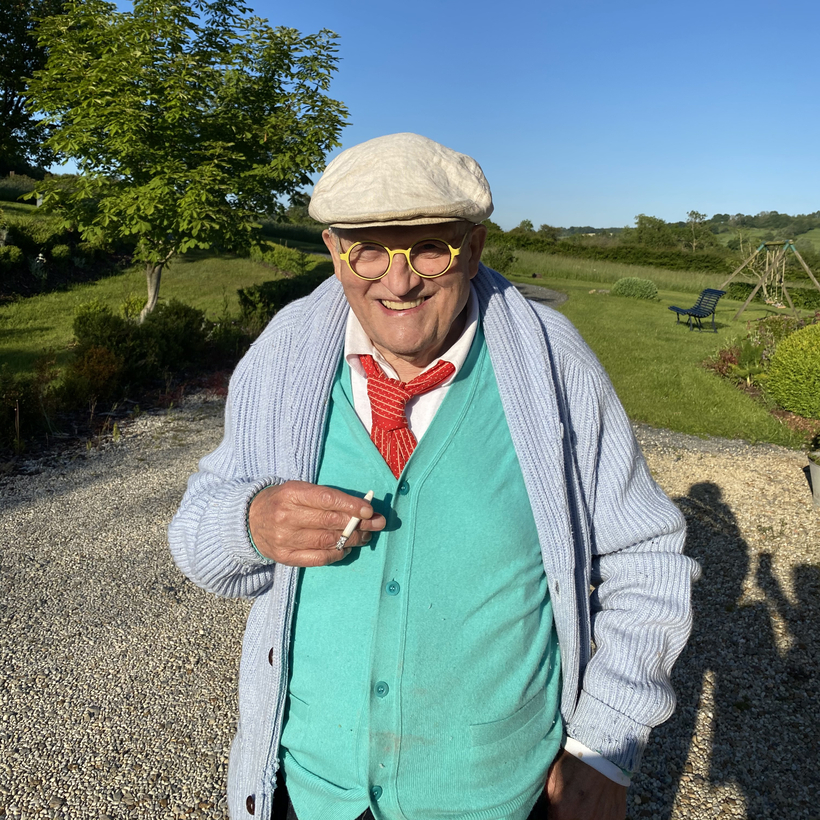David Hockney trusts his instincts. In 2018, while in London to unveil his Westminster Abbey windows in honor of the Queen, Hockney decided he needed a break. He and his longtime assistant, Jean-Pierre Gonçalves de Lima (J.P.), escaped to Honfleur on the coast of Normandy. Besides the appealing prospect of a few days of rest and good food, Hockney was on a mission: he wanted to revisit Queen Matilda’s 11th-century tapestry at nearby Bayeux.
Hockney found what he was searching for. It confirmed his hunch that the enormous 230-foot-long embroidered cloth was actually an anomaly in the history of Western picture-making. Not only does the tapestry vividly chronicle the two-year-long Norman conquest of England—which culminated with the Battle of Hastings, in 1066—it does so, Hockney realized, without using shadows or reflections. For Hockney, the Bayeux tapestry had more in common with Chinese scroll painting (also devoid of shadow and reflection) than with Western image-making. Hockney saw that one had to “read” the tapestry in time and in sections—just as one unfurls a scroll.
He would paint nature in a new way. A few days later, Hockney decided to move with J.P. to Normandy.
Chez Hockney
They bought a rustic 17th-century half-timbered cottage that was bordered by rows of poplars, scatterings of fruit trees, and shrubbery, on a large expanse of open land. Softly rolling distant hills, a small pond, and a little river completed the bucolic setting. An old cider-press outbuilding just steps away from the house would be Hockney’s studio. Hockney flew to Los Angeles while J.P. stayed to organize the new house and supervise the construction of the studio.

He returned to Normandy in early March 2019. Though the new studio was not yet finished, Hockney, undeterred, got on with his work. Over the next several days, led by the lessons of Bayeux, Hockney filled an eight-inch-by-11-foot Japanese concertina sketchbook with a panoramic ink drawing of his new surroundings. Opening in accordion-like fashion, Hockney’s drawing makes a 360-degree circle around the house, ending at the same point from which it started. Larger ink drawings made in the same fashion followed. Shortly afterward, Hockney’s new studio was ready and he began painting on canvas as well as making drawings on his trusty iPad—a medium he has championed for the past decade. Before too long, both the studio and the house were filled with new work.
Hockney saw that one had to “read” the tapestry in time and in sections—just as one unfurls a scroll. He would paint nature in a new way.
On October 15, in Paris, a dozen of Hockney’s new paintings, iPad drawings, and editioned prints, all created during his first year in his new French abode, go on view at Galerie Lelong & Co. The exhibition is titled “David Hockney: Ma Normandie,” and it features various paintings of his house and studio; the lush surrounding landscape in different seasons; and a marvelous painting of rain entitled, in Hockney-esque fashion, Some Smaller Splashes. A large diptych panorama painting and another print of the circular village center of nearby Beuvron-en-Auge are the only subjects to be found outside Hockney’s intimate domain. Especially for the Lelong exhibition, Hockney has installed two large-scale facsimile prints of the panorama ink drawings he made upon his arrival. Measuring 2.5 feet tall by 39 feet long, they are titled Around the House, Winter, and Summer. Three recent 2020 iPad drawings of a lit and unlit fireplace, and a still life of a vase, jug, and sheaf of wheat, round out the show.

All of the works in the Lelong show were created by Hockney before the arrival of the pandemic. Last February, he traveled to London for the opening of two exhibitions: a retrospective drawing show at the National Portrait Gallery (now on display at the Morgan Library & Museum, in New York) and a show at the Annely Juda Fine Art gallery. He returned to Normandy in early March, just as France went into lockdown. But Hockney didn’t let the coronavirus get him down. Early on, through e-mail, he sent out a cheerful iPad drawing of daffodils, which he titled Do Remember They Can’t Cancel Spring. In the past seven months, he has created more than 100 new iPad drawings of his second spring in Normandy. These new works will be presented in a major exhibition next spring at London’s Royal Academy.

If anything, Hockney has enjoyed the seclusion. Supported by J.P. and another assistant, Jonathan Wilkinson, as well as his studio staff back in Los Angeles, he is having one of his most productive periods in an already prolific 60-plus-year career. “I’m still smoking here in Normandy, fresh air and fresh cigarettes,” he says. “And I am still going strong at 83. We don’t have a television, although I occasionally look at the BBC on my iPad—but more often than not I am drawing on it.”
Hockney keeps up with his friends by video calls, and e-mails his new work to us several times a week. On a recent FaceTime call with him, I complained about this challenging period we’re living through. Hockney suggested I watch old Benny Hill comedy shows like he and J.P. were bingeing on that evening. “You’ve got to laugh more, Charlie,” he tells me. “It clears the lungs.”
Charlie Scheips is a painter, writer, and curator living in New York City

